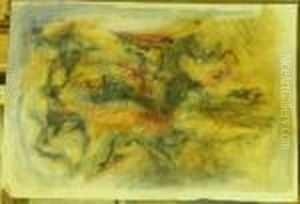Maurice Blot Paintings
Maurice Blot was a French artist known for his contributions to the post-war art movement in Europe, particularly in France. Born in 1932, Blot's early life was marked by the turmoil of World War II, an experience that would later influence his artistic expressions. He emerged as an artist in the 1950s, a period when Europe was in the throes of recovery and cultural rebirth. Blot's work from this era reflects a fascination with the human condition, often exploring themes of existentialism and the abstract representation of emotions.
Blot's artistic journey was characterized by his relentless experimentation with materials and forms. He was part of a generation of artists who sought to break away from traditional artistic expressions, exploring instead the potentials of abstract art. His paintings often featured bold colors, dynamic shapes, and a sense of movement that seemed to capture the complexity of post-war sentiments. Despite his affinity for abstraction, Blot never completely abandoned the human figure, which remained a central, though often abstracted, element in his work.
Throughout the 1960s and 1970s, Blot's reputation grew, both in France and internationally. His work was exhibited in numerous galleries and museums, earning him critical acclaim and a dedicated following. He was known for his ability to merge the emotional intensity of expressionism with the intellectual rigor of abstraction, creating works that were both visually striking and deeply thought-provoking.
In the latter part of his career, Maurice Blot continued to evolve, exploring new technologies and media. He was particularly interested in the intersection of art and digital technology, experimenting with digital painting and installation art. Despite these forays into new media, he remained committed to the exploration of the human condition, a theme that had been central to his work from the outset.
Maurice Blot passed away in 2023, leaving behind a rich legacy of artistic innovation and exploration. His work continues to be celebrated for its contribution to the development of modern art in Europe and for its profound exploration of the complexities of human emotion and experience.

